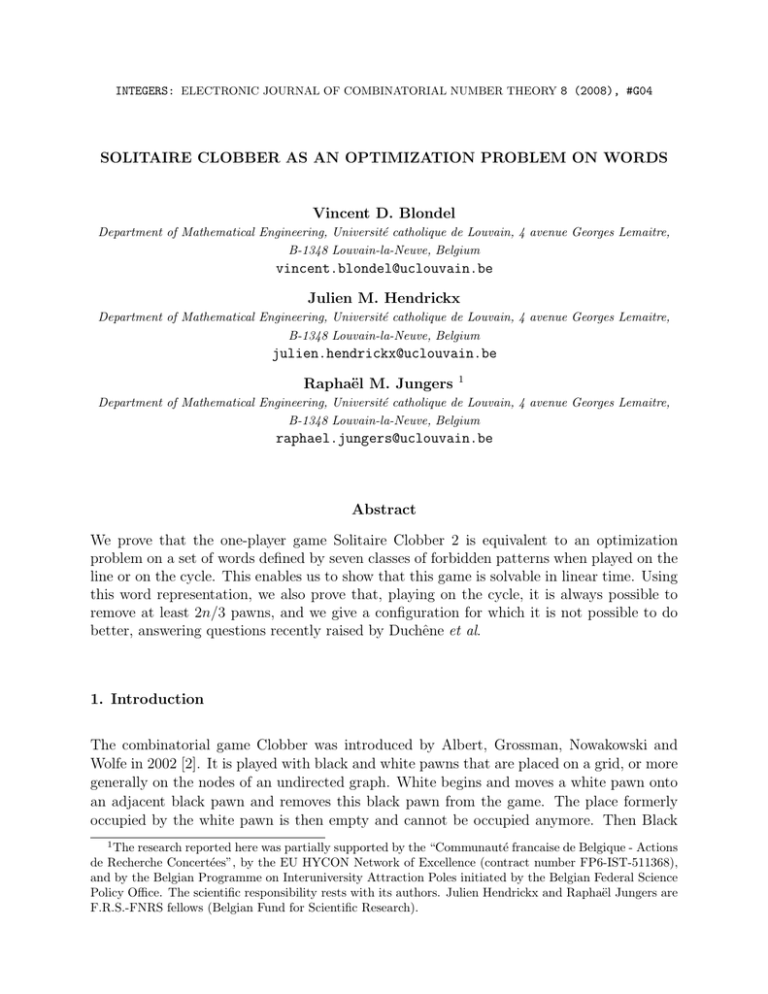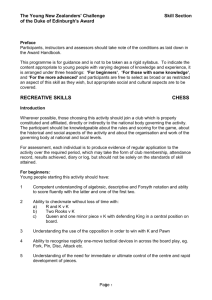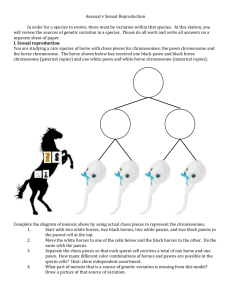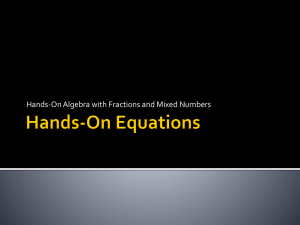SOLITAIRE CLOBBER AS AN OPTIMIZATION PROBLEM ON WORDS Vincent D. Blondel
advertisement

INTEGERS: ELECTRONIC JOURNAL OF COMBINATORIAL NUMBER THEORY 8 (2008), #G04
SOLITAIRE CLOBBER AS AN OPTIMIZATION PROBLEM ON WORDS
Vincent D. Blondel
Department of Mathematical Engineering, Université catholique de Louvain, 4 avenue Georges Lemaitre,
B-1348 Louvain-la-Neuve, Belgium
vincent.blondel@uclouvain.be
Julien M. Hendrickx
Department of Mathematical Engineering, Université catholique de Louvain, 4 avenue Georges Lemaitre,
B-1348 Louvain-la-Neuve, Belgium
julien.hendrickx@uclouvain.be
Raphaël M. Jungers
1
Department of Mathematical Engineering, Université catholique de Louvain, 4 avenue Georges Lemaitre,
B-1348 Louvain-la-Neuve, Belgium
raphael.jungers@uclouvain.be
Abstract
We prove that the one-player game Solitaire Clobber 2 is equivalent to an optimization
problem on a set of words defined by seven classes of forbidden patterns when played on the
line or on the cycle. This enables us to show that this game is solvable in linear time. Using
this word representation, we also prove that, playing on the cycle, it is always possible to
remove at least 2n/3 pawns, and we give a configuration for which it is not possible to do
better, answering questions recently raised by Duchêne et al.
1. Introduction
The combinatorial game Clobber was introduced by Albert, Grossman, Nowakowski and
Wolfe in 2002 [2]. It is played with black and white pawns that are placed on a grid, or more
generally on the nodes of an undirected graph. White begins and moves a white pawn onto
an adjacent black pawn and removes this black pawn from the game. The place formerly
occupied by the white pawn is then empty and cannot be occupied anymore. Then Black
The research reported here was partially supported by the “Communauté francaise de Belgique - Actions
de Recherche Concertées”, by the EU HYCON Network of Excellence (contract number FP6-IST-511368),
and by the Belgian Programme on Interuniversity Attraction Poles initiated by the Belgian Federal Science
Policy Office. The scientific responsibility rests with its authors. Julien Hendrickx and Raphaël Jungers are
F.R.S.-FNRS fellows (Belgian Fund for Scientific Research).
1
INTEGERS: ELECTRONIC JOURNAL OF COMBINATORIAL NUMBER THEORY 8 (2008), #G04
2
plays similarly with the black pawns, etc. The player making the last move wins the game.
Starting from the following initial configuration (where pawns lie on a line):
!"!"!"!",
the first play of White could be !"!"!"" . Black could follow with !"!! "" , after which
White could win by playing " !! "" as Black would then be unable to play (It can be
proved that with this initial alternate configuration of length 8, the first player can always
win). This game has received increasing attention for the last years, and it is for instance
possible to play Clobber on the web [1]. Also, finding an optimal strategy has been shown
to be NP-hard [2]. The game of Clobber, though very simple at first sight, has led to many
open problems in combinatorial game theory. No optimal strategy is known, even for some
simply-looking configurations. For instance, the line configuration with alternate coloring of
length 2n has been conjectured to be first player winning for any natural n != 3 [2], and this
conjecture has not been settled.
We study here Solitaire Clobber, which is a one-player version of this game, introduced
by Demaine et al. [3].
There are two ways to define this one player version. In one version, the player is forced
to play alternatively with white and black pawns as in the 2-player game. In a second version
“Solitaire Clobber 2”, the player can move a black or a white pawn at each turn.
In both versions of the game, the goal is to remove as many pawns as possible. The smallest number of remaining pawns that can be obtained from a particular initial configuration is
called the reducibility value of this configuration. Little is known about these games except
that both are difficult. More precisely, in both cases it is NP-complete to determine the
reducibility value of a given initial configuration even if the underlying graph is a simple grid
[3, 4]. We focus on the second version of the solitaire game, where the player can chose at
each turn the color he plays. In the sequel we simply refer to the second version as “Solitaire
Clobber”.
In [4] Duchêne et al. independently proved that the reducibility value of an initial configuration on a line (1 × n grid) can be computed in linear time. From their method, they
deduce a quadratic time algorithm to compute the reducibility value of configurations on a
cycle, which they conjecture to be never larger than n/4 + O(1). We show in this paper that
the reducibility value of a configuration on both the line and the cycle can be computed in
linear time by an algorithm which also provides a sequence of moves reaching this value. We
also exhibit a class of configurations on a cycle whose reducibility value is n/3 + O(1), thus
disproving the conjecture of Duchêne et al.2 for cyclic configurations.
The paper is organized as follows: In Section 2 we reformulate Solitaire Clobber on a line
as an optimization problem over words. We give then in Section 3 an algorithm that solves
This conjecture was made in a preprint version of [4], which did not contain the result on the linear time
algorithm to compute the reducibility value of a configuration on the line. The latter result has since then
been added to [4] after having been obtained independently by Duchêne et al.
2
INTEGERS: ELECTRONIC JOURNAL OF COMBINATORIAL NUMBER THEORY 8 (2008), #G04
3
this problem in O(n) operations and explicitly provides an optimal strategy for the given
configuration. Finally in Section 4 we adapt this algorithm to the cyclic case and prove that
the worst reducibility value on a cycle is n/3 + O(1).
2. Reformulation as an Optimization Problem
In this section we formulate Solitaire Clobber on the line as an optimization problem on a
finite set of words. For a given configuration, we construct a set of words that represent
games on this configuration. The optimal strategy is obtained by choosing the word in
this set that minimizes the occurrence of a special letter. We denote by c the binary word
representing an initial configuration, with ci = ! or ", and by n the length |c| of this initial
configuration. We also denote by c[i,j] : i ≤ j the subword ci . . . cj . Before defining our set of
words, we show that some moves, although allowed by the rules of Clobber, are never needed
in the game.
Proposition 1. For each game of Solitaire Clobber, there is another game in which the
same number of pawns are removed and such that no pawn having already moved is taken by
a pawn that has not moved yet.
Proof. Suppose that a pawn A having not moved yet takes a pawn B having already moved.
For this to be possible, A and B must have different colors and be adjacent before the move.
And since B has already moved, it is adjacent to no other pawn as its previous position
must be empty, as for example in !"AB !. So if A takes B it becomes isolated (adjacent to
two empty positions) as in !" A !, and never interacts with another pawn anymore. Thus,
by having B taking A instead of the converse as in !"B !, one does not remove any (and
often add some) possible further interaction or pawn removal.
We therefore assume in the sequel that a pawn having already moved is never taken by a
pawn that has not moved yet.
By the rules of Solitaire Clobber, a pawn can only move from an occupied position to
an adjacent occupied position, and an empty position thus never gets re-occupied. Suppose
that at some point of the game a pawn moves from i to i + 1 (resp. from i + 1 to i). The
position i (resp. i + 1) is then empty and no pawn can move from or to it. As a consequence,
no pawn can cross the separation between i and i + 1 anymore. This proves the following
lemma.
Lemma 2. A separation between two adjacent positions is crossed by at most one pawn.
Consider now a game of Solitaire Clobber starting on an initial configuration c. Based on
the lemma above, we associate a word w of length |w| = n − 1 to the game by associating a
letter to each separation, depending on whether or not it initially separates pawns of different
INTEGERS: ELECTRONIC JOURNAL OF COMBINATORIAL NUMBER THEORY 8 (2008), #G04
4
colors, and whether or not it gets crossed by a pawn during the game. A letter s is used for
wi when the two initial pawns have the same color: ci = ci+1 , and a letter a is used when the
→ over the letter if the separation gets
colors alternate: ci != ci+1 . We add a right arrow: −
− if it gets crossed by a pawn
crossed by a pawn coming from i to i + 1, and a left arrow: ←
coming from i + 1 to i. If it does not get crossed, we just add a bar . Thus, to each game
→
→
−
−
starting with n pawns corresponds a unique word w ∈ Σn−1 , with Σ = {a, s, −
a ,−
s ,←
a ,←
s },
n−1
and Σ
is the set of words of length n − 1 on the alphabet Σ. For example, the following
game
(1)
!!""! ⇒ !!" " ⇒ !" " ⇒ "
"
−
−
→
is associated with the word ←
s←
a s−
a . In the sequel, we use x as a “don’t care” letter. The
−
→
−
→
→
→
→
→
expression x s denotes for instance both −
s−
s and −
a−
s.
Not every word on Σ corresponds to a valid game of Solitaire Clobber. For example, the
→
→
→
word −
s−
s−
s would correspond to a game where all pawns have the same color and where
nevertheless one would take the three others, which is impossible. We say that a word w
is admissible for an initial configuration c if it can be associated with a valid game on this
initial configuration. By extension, we say that a word is admissible if it is admissible for at
least one initial configuration. Since black and white pawns have symmetric roles and since
to a sequence of s and a we can associate two possible initial configurations, it can be seen
that an admissible word is always admissible for exactly two opposite initial configurations.
During a game of Clobber, the number of removed pawns is equal to the number of
moves, and therefore to the number of separations crossed by pawns. In the corresponding
→
−. So
word w, the number of removed pawns is thus the number of occurrences of −
x and ←
x
the reducibility value of an initial configuration c is the minimum number of occurrences of
x in all words admissible for c, increased by 1 as those words only have n − 1 letters. Let us
define the seven following classes of forbidden patterns.
−−
→
1. {←
x
x}
→
−
2. {−
s←
s}
→
−
3. {x−
s ,←
s x}
→
→
→
→
→
−←
−
−, x←
−
−}
4. {−
x−
a−
x ,−
x−
a x, ←
x
a←
x
a←
x
→
−
→
−
5. {x−
a←
s ,−
s←
a x}
→
→
−
−}
6. {−
x−
a←
a←
x
→
−
7. {x−
a←
a x}
In the remainder of this section, we prove the two following theorems.
Theorem 3. A word w is admissible if and only if xwx contains none of the patterns (1)-(7).
INTEGERS: ELECTRONIC JOURNAL OF COMBINATORIAL NUMBER THEORY 8 (2008), #G04
5
Theorem 4. Let c be an initial Clobber configuration. It is possible to reduce c to k pawns
if and only if there exists a word w ∈ Σ|c|−1 such that
→
−
→
−
• for each i, wi ∈ {−
s ,←
s , s} if ci = ci+1 and wi ∈ {−
a ,←
a , a} else.
• xwx contains none of the forbidden patterns (1)-(7)
• w contains exactly k − 1 occurrences of x
Moreover, a sequence of plays reducing c to k pawns can then be deduced in linear time from
w.
We first prove that the patterns (1)-(7) never appear in a valid word. For this purpose,
we need two obvious lemmas.
Lemma 5. During a game, no more than two pawns can move onto a certain position i.
If two pawns move to i, one comes from i − 1 and the other one from i + 1, and they have
different colors. The second to move has the same color as the pawn initially on i and
becomes isolated after its move so that it cannot take or be taken by any other pawn.
→
→
−←
−), the move from position
Lemma 6. In an admissible w where w[j−1,j] = −
x−
x (resp. ←
x
x
j to j + 1 represented by wj takes place after the one from j − 1 to j represented by wj−1 .
Both are made by the same pawn, whose color is opposite to the color cj .
Proposition 7. An admissible word never contains any of the forbidden patterns (1)-(7).
Proof. For each class of patterns, we suppose that there is a game of Solitaire Clobber for
which the associated word w contains the pattern, and show that this leads to a contradiction.
−−
→
(1) ←
x
x : This corresponds to a situation where two pawns leave a position, which is
impossible as once the position has been left it is empty and never gets re-occupied.
→
−
→
−
(2) −
s←
s : Suppose that w[i−1,i] = −
s←
s , pawns initially on positions i − 1, i, i + 1 have
the same color, say white without loss of generality. At some time a pawn A moves from
position i − 1 to i and at some other time an other pawn B moves from position i + 1 to i.
It follows from Lemma 5 that A and B are of different colors. Suppose that A is white like
the pawn C initially on the position i, and that B is black (By symmetry this does not lead
to a loss of generality). Then B first takes C and is then taken by A. This must be the first
move of A for otherwise two pawns (a black one and then A) would already have moved to
i − 1 where the initial pawn was white, and it follows from Lemma 5 that A would then be
isolated and unable to take B. The additional rule introduced after Proposition 1 is thus
clearly violated as A which has not moved yet takes B which has already moved.
→
−
→
(3) x−
s (and ←
s x): Suppose that w[i−1,i] = x−
s , and let A and B be the pawns initially
located on the positions i, and i + 1. No pawn moves to the position i during the game, and
INTEGERS: ELECTRONIC JOURNAL OF COMBINATORIAL NUMBER THEORY 8 (2008), #G04
6
therefore the pawn moving from i to i + 1 is A, and it is its first move. Since A and B have
the same color, B needs to have first been replaced by a pawn C of another color, which
violates the rule introduced after Proposition 1.
→
→
→
→
→
−←
−
−, x←
−
−): Suppose that w
(4) −
x−
a−
x, −
x−
a x (and their symmetric versions ←
x
a←
x
a←
x
[i−1,i] =
−
→
−
→
x a , and without loss of generality that c[i,i+1] = "!. It follows from Lemma 6 that the pawn
moving from position i to i + 1 first moved from position i − 1 to i and is black. Therefore it
cannot move to position i + 1 if this position is not occupied by a white pawn, which initially
is not the case. The only way to have position i + 1 occupied by a white pawn is to have
−, forbidding the patterns −
→
→
→
it coming from position i + 2, which implies that wi+1 = ←
x
x−
a−
x
−
→
−
→
and x a x. A symmetric argument can be applied to forbid the two symmetric versions of
these patterns.
→
−
→
−
→
−
(5) x−
a←
s (and its symmetric version −
s←
a x): Suppose that w[i−1,i+1] = x−
a←
s and without loss of generality that c[i,i+2] = !"". During the game, no pawn moves to position i, and
therefore the pawn leaving i for i + 1 is the black one initially on i, which we call A. Let B
be the pawn moving from i + 2 to i + 1, and suppose first that B was initially not on i + 2.
Then by Lemma 5 it must be black to be able to arrive on i + 2 and move afterwards, and
−
can thus not take nor be taken by A, contradicting the fact that wi+1 = ←
s . So, B is initially
on i + 2, and can only move to i + 1 once the initial white pawn has been taken by A. This
is however forbidden by the rule introduced after Proposition 1.
→
→
−
−: Consider a word w for which w
−
→−
→←
−←
−
(6) −
x−
a←
a←
x
[i−2,i+1] = x a a x . Without loss of
generality, we can assume that c[i−1,i+1] = "!". During the game, two pawns move to
position i. It follows from Lemma 5 that they have different colors. But applying Lemma 6
to w[i−2,i−1] and to w[i,i+1] shows that they must both be black.
→
−
→
−
(7) x−
a←
a x: Suppose that w[i−2,i+1] = x−
a←
a x and without loss of generality that c[i−1,i+1] =
"!". During the game, no pawn moves to position i − 1 nor to the position i + 1. Therefore,
the two white pawns initially on these positions both move to position i, which by Lemma
5 is impossible.
In order to prove now that forbidding those patterns is sufficient to characterize the set
of admissible words, we need the following lemma.
Lemma 8. Two words w, w" are admissible if and only if the word wxw" is admissible. As
a consequence, wx, xw and xwx are admissible if and only if w is admissible.
Proof. Just observe that wxw" represents a Solitaire Clobber game which is the juxtaposition
of two games represented by w and w" . The second part of the result follows from the fact
that the empty word is valid and corresponds to an empty game on an initial configuration
of one pawn.
Proposition 9. Any word w such that xwx contains none of the forbidden patterns (1)-(7)
is admissible.
INTEGERS: ELECTRONIC JOURNAL OF COMBINATORIAL NUMBER THEORY 8 (2008), #G04
7
Proof. It follows from a recursive application of Lemma 8 that this proposition needs only to
be proven for words not containing any occurrence of x. Consider such a word w. Because
→
−)q .
of the forbidden pattern (1), it must have the form w = (−
x )p (←
x
We first treat the case where q = 0, p > 0, which by symmetry is equivalent to the case
→
→
where p = 0, q > 0. Since the pattern (3) x−
s is forbidden in xwx, w1 = −
a . Then because
−
→
−
→
−
→
−
→
−
→
−
→
patterns (4) x a x and x a x are forbidden, all other wi are s . Assuming without loss of
generality that the first pawn is black, the initial configuration corresponding to w is thus
!"p , and w can be associated with a game where the first pawn moves p times to the right,
taking all the white pawns.
→
−
Suppose now that p, q > 0. Due to forbidden patterns (3), w1 = −
a and wp+q = ←
a . This
−
→
←
−
excludes the possibility of having p = q = 1 as the pattern (7) x a a x is forbidden in xwx.
→
→
→
−←
−
− belong to class
Let us assume that p, q > 1. Because the patterns −
x−
a−
x and ←
x
a←
x
→
−
(4) and therefore do not appear in xwx, there holds wi = −
s for 1 < i < p and wi = ←
s for
−
→
←
−
p + 1 < i < p + q. There remains to characterize w[p,p+1] . Since the patterns (2) s s and
→
→
−
− are forbidden, it must be either −
→
−
→
−
(6) −
x−
a←
a←
x
a←
s or −
s←
a . Without loss of generality, we
−
→
←
−
assume that w[p,p+1] = s a . Supposing that the first pawn is black, the initial configuration
is then ! "p !q−1 ", and there is a valid game with which w can be associated. The black pawn
initially on the first position begins by taking the p white pawns on its right to obtain a
configuration !q ". The white pawn on the last position then takes the q black pawns on its
left. At the end, p + q pawns have been removed.
There remains to consider the case where p = 1 and q > 1, and its symmetric version.
→
−
→
−
Since the pattern (5) x−
a←
s does not appear in xwx, we must have w[1,2] = −
a←
a . Due
←
−
again to the forbidden patterns of (4), there holds wi = s for 2 < i < p + q, so that
→
−
−
−
w = −
a←
a (←
s )q−2 ←
a . Supposing that the first pawn is black, the initial configuration is
q−1
! "!
" and a valid game of Clobber can again be associated with w, in the same way as
when p, q > 1.
Proposition 9 states that a word w such that xwx contains none of the forbidden patterns
is admissible. The juxtaposition of these x letters is needed to prevent a pawn from leaving
or arriving on the extremal positions from outside the game. Suppose now that a word w is
admissible. Then it follows from Lemma 8 that xwx is also admissible and therefore contains
none of the forbidden patterns due to Proposition 7. The absence of forbidden pattern in
xwx is thus a necessary and sufficient condition for admissibility of w, which proves Theorem
3. This combined with the fact that the number of remaining pawns at the end of the game
depends on the number of occurrences of x proves Theorem 4.
INTEGERS: ELECTRONIC JOURNAL OF COMBINATORIAL NUMBER THEORY 8 (2008), #G04
8
3. Solving Clobber in Linear Time
In this section we give a linear time algorithm allowing one to compute the reducibility
value of a line Solitaire Clobber configuration. A byproduct of this algorithm is an optimal
strategy for this particular Solitaire Clobber game. We use results of the previous section,
so we have to find an admissible word for c that minimizes the number of x letters. In order
to have a simple algorithm, we first restate Theorem 4 with a simplified alphabet, shorter
forbidden patterns and a modified necessary and sufficient condition for admissibility. We
→
→
−
−
define our new alphabet Σ" = {x, −
a ,−
s ,←
a ,←
s } by merging a and s into x. Moreover we
→
→
−
− and (7) x−
→
−
replace the forbidden patterns of length four (6) −
x−
a←
a←
x
a←
a x by shorter ones,
−
→
−
→
←
−
−
→
←
−
→
−
− and x−
→
−
namely (6’) x a a and (7’) a a x. Note that their symmetric versions −
a←
a←
x
a←
a
are still allowed.
Theorem 10. Let c be an initial clobber configuration. It is possible to reduce c to k pawns
if and only if there exists a word w ∈ Σ"(|c|−1) consistent with c containing exactly k −1 occurrences of x and such that xxwxx contains none of the forbidden patterns (1)-(5),(6’),(7’).
Moreover, a sequence of moves reducing c to k pawns can then be deduced in linear time from
w.
Proof. We begin by proving that patterns (6’)-(7’) can replace patterns (6)-(7). Forbidding
→
→
−
→
→
−
−, so we need only to prove that the former pattern
(6’) −
x−
a←
a implicitly forbids (6) −
x−
a←
a←
x
can always be avoided in a valid word without affecting the number of removed pawns.
→
→
−
Suppose that there is a valid game for which w[i−1,i+1] = −
x−
a←
a and without loss of generality
that c[i,i+2] = "!". It follows from Lemma 6 that the pawn A making the move from i to
i + 1 is black and therefore that the move takes place after that a white pawn B has come on
position i + 1. Instead of having A taking B, one can equivalently have B taking A without
violating any rule of Clobber, nor any of the forbidden patterns, and without removing any
→
→
−
→
−
−
possible future interaction. So w[i−1,i+1] = −
x−
a←
a can always be replaced by −
x←
a←
a , and
can therefore be forbidden. Observe now that due to this new forbidden pattern the pattern
−
→
→
−
−−
→
−
→
−
x−
a←
a x is forbidden, and so are ←
x
a←
a x and x−
a←
a x due to the forbidden patterns (1)
→
−
and (7). As a consequence, the pattern −
a←
a x is implicitly forbidden, and we can forbid
→
−
it explicitly without removing any word corresponding to a valid game. Since −
a←
a x is a
subpattern of (6), we do not need then to explicitly forbid this latter pattern anymore.
One can see that a and s never appear separately in the forbidden patterns, but always
under the form x. Indeed, if the separation between two positions is not crossed by any
pawn, the fact that the pawn initially on those positions have same or different colors has
no influence on the game. Since a and s also have exactly the same influence on the number
of removed pawns, we can merge them into one letter x.
Finally, a word w is admissible if and only if xwx contains none of the forbidden patterns.
It follows from Lemma 8 that an equivalent necessary and sufficient condition is the absence
of the forbidden pattern in xxwxx.
INTEGERS: ELECTRONIC JOURNAL OF COMBINATORIAL NUMBER THEORY 8 (2008), #G04
9
Since the forbidden patterns have length three, we would like to represent somehow the
subsequences of length three of an admissible word. For this purpose, we use a standard
trick in coding theory, which is called higher power coding [5]. The best way to represent
this is to construct a directed graph G(V, E) whose vertices are all sequences of two letters:
V = {v1 v2 : v1 , v2 ∈ Σ" }. Since there are five different letters in our alphabet Σ" , the graph
has 25 vertices. For any word w of length n, there is a unique sequence of vertices in the
graph: w[1,2] , w[2,3] , . . . w[n−1,n] . Let us consider the complete graph (with self loops allowed)
on these 25 vertices. Clearly, one has to forbid edges from any node v to any node v "
whenever v2 != v1" . We also remove edges (v, v " ) such that the word v1 v2 v2" is forbidden. Any
path in the remaining graph which begins and ends at the node xx represents a word xxwxx
satisfying the conditions of Theorem 10 and therefore a valid game of Solitaire Clobber: the
third vertex of the path corresponds to the first two letters of w, and each jump from one
vertex v to another v " corresponds to the concatenation of the letter v2" . We are now able to
state the main theorem of this paper:
Theorem 11. The optimal word admissible for an initial configuration c can be found in
Θ(|c|). As a consequence, the reducibility value of c and a sequence of moves reaching this
value can be found in linear time.
Proof. Let c be a given configuration of length n. We would like to find a word w admissible
for c and minimizing the number of letters x. By Theorem 10, this is equivalent to finding
a path of length n + 1 in our graph such that
1. The first and last vertices of the path are xx.
2. The corresponding word represents a game on the initial configuration c. More precisely, the second letter of the ith vertex is of the type a (resp. s) if wi−1 must be of
the type a (resp. s), x being of both types.
3. The word minimizes the occurrences of x; that is, the path minimizes the number of
vertices whose second letter is x.
An efficient way to do that is to weight the edges: an edge has a weight one if it points
to a vertex of which the second letter is x, and a weight zero either. Hence, ne then needs
only to find a path of minimal weight among those satisfying the first two constraints above.
This can easily be done in linear time: For l = 1 . . . n + 1 one just needs to compute and
store the paths of minimal weight of length l from the node xx to each node in the graph.
This latter computation can be performed dynamically for growing l with a constant cost at
each step. Let indeed fl (v) be the minimal weight of any path of length l arriving at v and
pv! ,v the weight of the edge connecting v " to v. The following recurrence holds
fl (v) = min
(fl−1 (v " ) + pv! ,v ) ,
!
v
(2)
where the minimum is taken on all v " such that (v " , v) is allowed as lth edge. As the number
of edges and of vertices is bounded, each iteration can be done in O(1).
INTEGERS: ELECTRONIC JOURNAL OF COMBINATORIAL NUMBER THEORY 8 (2008), #G04
10
At each position of the path in the graph above, only at most 9 vertices among the 25
of the graph are allowed. Indeed for each l at most 9 vertices satisfy condition (2), i.e.
are consistent with the initial configuration. Moreover, the in and out-degrees of a vertex
are at most 3 if only edges connecting vertices consistent with the initial configuration are
considered. So, equation (2) has to be computed for at most 9 vertices, and each time at
most three vertices v " have to be considered.
4. Solitaire Clobber on a Cycle
In this section we analyze the cyclic configuration for Solitaire Clobber, and answer questions
recently raised in [4]. We briefly show how the results of the previous sections generalize to
the cycle, and we give then a linear time algorithm for computing the reducibility value of a
cyclic Solitaire Clobber game. We then prove that the maximal reducibility value on a cycle
is n/3.
Theorem 12. The reducibility value of a Solitaire Clobber game on a cycle is computable
in linear time.
Proof. Let us consider a configuration for which there are black and white pawns. Without
loss of generality, let us suppose that c[1,2] = !". Observe that if the black pawn initially
on c1 moves to the right, the problem becomes equivalent to a Solitaire Clobber on the line
with configuration c. Also, if this pawn moves to the left, the problem becomes equivalent
to a Solitaire Clobber on the line with configuration c[2,n] c1 . The same analysis can be done
with the white pawn initially on c2 . Now if neither of these pawns moves, at least one of
them has to be removed from the game at the end, for otherwise the number of removed
pawn could be increased by having one of them taking the other one. This is only possible if
the first black pawn at the right of c2 moves backward to c2 , or conversely if the first white
pawn at the left of c1 moves to c1 . In both cases, the game then becomes equivalent to a
Solitaire Clobber on the line. So the Solitaire Clobber on the cycle is equivalent to one of
the six situations presented above. Hence, one has only to compute the reducibility value of
these six games on the line, and the smallest one is the reducibility value of the cycle.
We now analyze the worst possible reducibility value on the cycle. It is proved in [3]
that the reducibility value of the so-called checkerboard configuration ( !")(n/2) on the line
is n/4 + O(1). One can check that this remains true when this configuration lies on a cycle.
In [4], Duchêne et al. ask whether this is the worst (non-trivial) reducibility value that can
be obtained on a cycle. We provide a negative answer to this question by showing an initial
configuration on the cycle for which the reducibility value is n/3, and prove then that no
higher value can be obtained. The configuration is simply the juxtaposition of the following
pattern: !"" .
Theorem 13. The cyclic configuration !""!"" . . . !"" has a reducibility value of n/3, where
n is the number of pawns in the initial configuration.
INTEGERS: ELECTRONIC JOURNAL OF COMBINATORIAL NUMBER THEORY 8 (2008), #G04
11
Proof. As done in Section 2 for the line, we can associate to each valid game of Solitaire
Clobber on the cycle a (cyclic) word of Σn . For exactly the same reasons as in Proposition
7, none of the patterns (1)-(7) appears in such a cyclic word if it can be associated with a
valid game.
A word representing a valid game of Solitaire Clobber on the cycle for this initial configuration must be of the form aasaas . . . aas. We split this word into “cells” aas, and first
prove that on average there is at least one letter x in each cell. More precisely, we show
that between two cells containing no letter x; there must be a cell with two such letters.
Suppose that a cell has no x letter, by applying the rules of Proposition 7, the cell must
→
−
−
→
→
−
−
be −
a←
a←
s or −
a−
a←
s and thus has a ←
s as last letter. This latter fact, combined with the
−
−
−
forbidden pattern (3) of Proposition 7, implies that the next cell must be ←
a as or ←
a a←
s . So,
←
−
either this cell has two x letters, or it has only one x letter, but then it also has s as last
letter. This implies that between two cells containing no x, there must be at least one cell
containing two letters x. The word therefore contains at most 2n/3 arrows corresponding
to the fact that at most 2n/3 pawns are removed, and the reducibility value of the game
is thus at least n/3. Observing that moving each black pawn twice to the right hand side
effectively removes 2n/3 pawns is then sufficient to achieve the proof.
We end this section by showing that n/3+O(1) is the worst possible reducibility value on
a cycle with n ≥ 3, except of course in the trivial case of a monochromatic cycle. Our proof
is constructive as it provides a simple strategy allowing the removal of at least 2n/3 − O(1)
pawns, for any Solitaire Clobber game on a cycle. The strategy is summarized as follows: cut
the cycle in such a way to obtain a line clobber game ending with "!, and remove iteratively
a maximum of pawns at the beginning of the line, letting at each step one pawn isolated.
We claim that it is always possible to remove at least two pawns at every step, except
perhaps for the last one. Indeed if the line begins with "", take the next black pawn (which
must exist since the line ends with "!) and remove all the beginning white pawns (there are
at least two of them). The situation is identical if the line begins with !!. If the line begins
with "!, and if these are not the last pawns, write the beginning of the line as "! . . . ! ". . . "!.
It is possible to remove all these pawns but the first one, by first moving the last (black)
one to the left until it sticks to the black series, and then removing this black series with the
first pawn. Still, more than two pawns are removed. If they are the two last pawns, one of
them can be removed. Finally, if the line begins with !", either the same argument can be
applied as for "!, or only two black pawns remain in the line, which is of the form ! ". . . "!.
In the latter case, which can happen only once during the game, all pawns can be removed
but two. So for each pawn that is not removed, there are always at least two pawns that are
removed, except at the end of the game where one or two pawns can be left while at least
one is removed. The number of remaining pawns is thus at most n/3 + O(1). This together
with Theorem 13 shows that the worst possible non-trivial reducibility value on the cycle is
n/3 + O(1).
INTEGERS: ELECTRONIC JOURNAL OF COMBINATORIAL NUMBER THEORY 8 (2008), #G04
12
5. Conclusions
In this paper, we have shown that playing Solitaire Clobber on a line or on a circle can
be viewed as an optimization problem on a set of words with forbidden patterns. This
equivalence has allowed us to design a linear-time algorithm computing the reducibility value
of an initial configuration and providing an optimal strategy, for both the cycle and the line.
This linear complexity is clearly optimal as reading the initial configuration already requires
n operations. Using this forbidden patterns approach and a simple alternative algorithm,
we were also able to easily prove that the maximal possible reducibility value on a cycle is
n/3 + O(1).
It remains open to determine to which extent our approach can be applied to other
topologies. On a general graph, one can build a “word” corresponding to a game of Solitaire
Clobber by assigning a symbol to every edge, in the same way as we do for each separation between positions. This is however most probably ineffective in the general case, as
computing the reducibility value is known to be NP-complete for general graphs [4].
References
[1] http://www.gottfriedville.net/games/clobber/index.htm.
[2] M. Albert, J. P. Grossman, R. J. Nowakowski, and D. Wolfe. An introduction to Clobber. INTEGERS:
The Electronic Journal of Combinatorial Number Theory, 5(2), 2005.
[3] E.D. Demaine, M.L. Demaine, and R. Fleischer. Solitaire Clobber. Theoretical Computer Science,
313(3):325–338, February 2004. Special issue of selected papers presented at the Schloss Dagstuhl
Seminar on Algorithmic Combinatorial Game Theory, 2002.
[4] E. Duchêne, L. Faria, and S. Gravier. Solitaire Clobber played on graphs. submitted.
[5] D.A. Lind and B.H. Marcus. An Introduction to Symbolic Dynamics and Coding. Cambridge University
Press, Cambridge, 1995.






